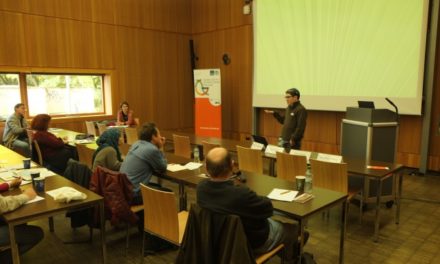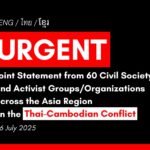By Mary Lou Malig
español
After the July Framework (1) was rammed through the July 2004 General Council, the mood of the big trading powers and the World Trade Organization (WTO) secretariat was triumphant. This was what they needed to move the talks forward after the derailment of the 2003 5th WTO Ministerial in Cancun, Mexico. As many analysts stated, the WTO achieved their main goal of saving the Doha Development Round and the multilateral trading system.
This mood carried on to September of this year as newly-appointed WTO Director General Pascal Lamy confidently announced that two-thirds of the round should be completed by Hong Kong. In negotiations parlance, this means that full modalities for the major areas of agriculture and non-agricultural market access (NAMA) would be set in place and other areas of negotiations would well be in motion.
After the recently concluded WTO General Council in October and the series of green rooms (2) and informal meetings that followed, the mood though has now changed from confident to faltering.
MOVING FULL SPEED AHEAD
The past two months have been very busy for the WTO members and the secretariat. October saw the WTO General Council in Geneva, a slew of informal meetings including the Five Interested Parties (FIPS) (3) meetings on agriculture and most recently, the new Quad plus one (4) and Super Green Room (5) meetings in London and Geneva respectively.
The October General Council meeting started off well for the big trading powers with a feeling that the negotiations were in motion. This was the common line from the chairs of the negotiation committees of agriculture, NAMA and services.
In agriculture especially, the chair was confident that things were moving in the right direction after the much-hyped offer of the US to cut its subsidies. And since agriculture has always been the make or break point of this round, this meant that negotiations would progress in other areas. As the chair Crawford Falconer stated, the most important proposals were already on the table reflecting a certain degree of progress already. (6)
Even Brasil, the leader of the G20, which opposed any movement in agriculture talks during the 5th Ministerial in Cancun, was now a staunch supporter of the progress. Brasilian Ambassador Clodoaldo Hugueney applauded the US proposal mainly credited for the movement, “that while it was not enough, it was a definite step forward.” (7)
There was also movement in the other major area of negotiations: NAMA. The chair of the NAMA negotiations, Stefan Johanneson was “optimistic that there was beginning to be convergence around a Swiss (8) or Swiss-type formula.” (9) Although this did not reflect the sentiments of other developing countries, this was still announced as progress.
Even the services chair, Mexico’s Ambassador Mateo felt confident that since things were moving in agriculture and NAMA, then services negotiations would move forward as well.
And since the road ahead looked like it was cleared of speed bumps, the WTO Secretariat was confident that a draft Ministerial text would be out by November 15.
CHANGING GEARS
A few days before the much-awaited November 15 deadline, the road no longer seemed so smoothe.
Although there were efforts by some like the services chair to produce several drafts of Ministerial texts on services, this did not amount to any progress in negotiations. On the contrary; because the draft texts contained many controversial elements that did not have consensus among majority of the members, it caused deeper divisions and stronger opposition.
The talk now is that the text will instead come out closer to the WTO General Council on December 2-3. This may also work to the advantage of the big trading powers as developing countries, with their smaller staff based in Geneva will not be able to react or register opposition to a draft if it comes out 24 hours before it is supposed to be passed by the General Council.
The main reason for the change has been the lack of movement of talks held in London and Geneva earlier this month. The press statements around it best describes the result, “On Wednesday November 9 several key member countries of the World Trade Organization (WTO) said they have reached an impasse and had run out of time to reach agreement on a draft trade deal supposed to be finalized at a WTO December 13-18 conference in Hong Kong.” (10)
From announcing that “negotiations are in motion” in October, the sentiment from the WTO members was now “recalibrating” expectations for the Hong Kong Ministerial. Members stated that prospects in Hong Kong will have to be scaled down.
The impasse is a result of the intransigence of the US and EU and their extreme demands of developing countries. While the US has made an offer in agriculture that is still not enough but welcomed nonetheless, the EU told developing countries bluntly that they cannot expect anything more unless they give more in NAMA and services.
The US and EU expected that their offers of superficial cuts of subsidies would require developing countries commitment to radically cut down industrial tariffs under NAMA and to offer more in services. Developing countries, however, have stood firm, at least for the moment, and demand that real cuts in subsidies be made first before they consider cutting industrial tariffs. “Clearly, there is a divide between those seeking high ambition in NAMA and services such as the United States and the EU and mostly developing countries seeking a “balanced” agenda cutting across all facets.” (11)
This clear lack of consensus brings back bad memories of the days before the Cancun Ministerial and so in a preventive move, the WTO has now changed tactic and stated that Hong Kong would now just be a pit stop on the road. This way, even if there is no progress or decision made at the Ministerial in Hong Kong, it will not be seen as a failure of the WTO. The WTO cannot afford another Seattle or Cancun as a third collapse would bring the institution into serious crisis.
The talk coming out of the WTO is that two more ministerials will be held in 2006, one to approve modalities (12) and one to conclude the Doha round. The first might be convened as early as March of 2006. This shows that, despite signs to the contrary, the WTO is still convinced that it can conclude the round by 2006.
MAKING UP THE RULES AS THEY GO ALONG
And why would the WTO not still be confident that it can conclude the round by 2006 when it has been changing the way things are done to suit its plan. Ever since Pascal Lamy, the former EU trade representative took the helm of the WTO, things started to change in major ways.
The first indication of this was reports coming out of Geneva that the WTO Director General himself would be drafting the text and that this would be brought to Hong Kong “under his own responsibility.” Traditionally, it has been the Chair of the General Council, together with the sectoral chairs, who produced the draft text for the Ministerial.
Following this precedent, the services chair produced several Ministerial texts without the consensus or majority agreement of the members. Worries are that the other chairs would follow suit and bring the text to Hong Kong “on their own responsibility” completely ignoring the process of consensus-building for drafting of texts.
Things have changed so much, in fact, that even this process of consensus has been redefined under Lamy’s watch. Consensus is now no longer needed to include elements in a text but rather it is needed to remove something from the text. This has caused outrage among developing country delegates and civil society.
Pascal Lamy has also redefined his role as Director General, taking over tasks of the chair of the General Council. The super green room or “mini-ministerial” that took place in Geneva on November 8-9 was not only chaired by Lamy, it was held in the actual premises of the WTO. Previous mini-ministerials, because they were informal, exclusive and were not part of the official decision-making process of the WTO, were held and hosted by WTO members. This time, the Director General has taken a proactive role and has, de facto, made it part of the official WTO decision-making process.
The secretariat, which is supposed to be the non-biased facilitator of negotiations between WTO members has now taken the driving seat. And as it looks now, Lamy is determined to conclude the round by having as many ministerials as it takes. When questioned on this, one WTO official said that there are no rules against this and that in fact they can have one every day.
DERAIL THE PIT STOP
While expectations for Hong Kong are played down, civil society, social movements and trade activists should be moving full-steam ahead. The negotiations are now at a stalemate and this is the opportunity to move in and ensure that no deal is made in Hong Kong and after. Developing countries are beginning to stand together and resist the pressure to further open up their markets. This is when pressure on national capitals should be kept up and the message of the people that there is nothing developmental about this round should be loud and clear. Civil society and social movements should swarm Hong Kong and their capitals during the 6th Ministerial and ensure that no progress is made in concluding the round.
* Marylou Malig coordinates Focus on the Global South’s trade campaign.
1. July Framework is a framework agreement mainly on agriculture reached at the General Council of July 31, 2004 in Geneva, Switzerland. It provides the operative framework for further negotiations on agriculture, non-agricultural market access and other issues.
2. Green Room refers to informal, secret meetings usually held alongside formal meetings of the WTO. This is common during Ministerials.
3. The Five Interested Parties is made up of the US, European Union, Australia, India and Brazil.
4. The new QUAD is composed of the US, European Union, India and Brazil. Japan was the special guest in the meeting in London.
5. Super Green Room refers to a larger version of the secretive informal meetings.
6. Focus on the Global South, Geneva Update No. 2, 18 October 2005
7. ibid
8. this is a harmonizing formula that uses a single mathematical formula to produce a narrow range of final tariffs.
9. Focus on the Global South, Geneva Update No. 2, 18 October 2005
10. Friends of the Earth International Press Release 11 November 2005
11. Washington Trade Daily, A Less Ambitious Hong Kong Conference, 9 November 2005
12. Modalities: Methodology to be followed during the negotiations



![[IN PHOTOS] In Defense of Human Rights and Dignity Movement (iDEFEND) Mobilization on the fourth State of the Nation Address (SONA) of Ferdinand Marcos, Jr.](https://focusweb.org/wp-content/uploads/2025/07/1-150x150.jpg)



